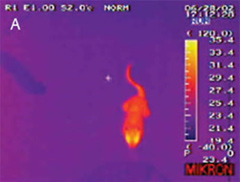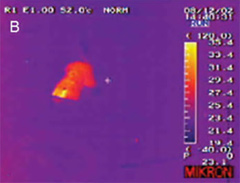Squirrels communicate with rattlesnakes using heated tail
Squirrels communicate with rattlesnakes using heated tail
mongabay.com
August 13, 2007
Ground squirrels heat their tails to defend their young against predatory rattlesnakes, reports a study published in the early online edition of Proceedings of the Natural Academy of Sciences (PNAS).
While scientists have long known that ground squirrels wave their tails at rattlesnakes, it was unclear why they did so more vigorously at night. Now, a paper led by Aaron S. Rundus of the University of California at Davis shows that squirrels are specifically signaling rattlesnakes, which can sense infrared radiation.
“Using an infrared camera, the researchers filmed squirrel-rattlesnake and squirrel-gopher snake encounters in the laboratory,” explained a statement from PNAS. “The squirrels turned on the heat in tail-waving displays of aggression when confronted by rattlesnakes. Faced with gopher snakes, which cannot see infrared, the squirrels waved their tails, but kept them cool.”
Squirrels confronted with rattlesnakes heated their tails by almost four degrees Fahrenheit while waving them in an alarming display.
  Images of a California ground squirrel during an encounter with a northern Pacific rattlesnake (top) and a Pacific gopher snake (bottom) taken from an infrared imaging video camera. These squirrels increase the amount of infrared radiation or heat they emit from their flagging tails during encounters with infrared sensitive rattlesnakes. When coupled with other forms of harassment this infrared signal serves as a deterrent shifting these predators of squirrel pups to a more defensive behavioral state. Images courtesy of Aaron Rundus. |
To test the sensitivity of the snakes, Rundus and colleagues then “confronted rattlesnakes with a stuffed robotic squirrel model fitted with a heatable tail. The rattlesnakes were wary of the waving robotic tail, but especially so when it was heated to the same temperature as the tail of a live squirrel engaging a rattlesnake.”
The results suggest that squirrels, which are partially immune to rattlesnake venom, have developed heated tails specifically to communicate with rattlesnakes.
The authors say that the findings provide another example of animals communication that is otherwise invisible to humans.
“These findings provide exceptionally strong support for the hypothesis that the sensory systems of signal targets should, in general, channel the evolution of signal structure,” they write. “Furthermore, the discovery of previously undescribed signaling modalities such as infrared radiation should encourage us to overcome our own human-centered sensory biases and more fully examine the form and diversity of signals in the repertoires of many animal species.”
CITATION: Aaron S. Rundus, Donald H. Owings, Sanjay S. Joshi, Erin Chinn, and Nicolas Giannini (2007). Ground squirrels use an infrared signal to deter rattlesnake predation.